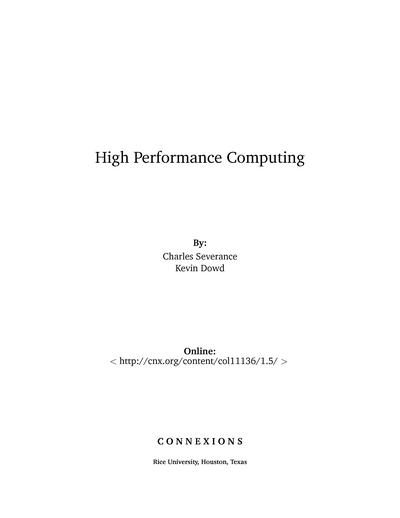
High Performance Computing
This book teaches new programmers and scientists about how modern workstations get their performance and how they can write code that makes optimal use of their hardware.
Tag(s): Parallel Computing
Publication date: 29 Oct 2012
ISBN-10: n/a
ISBN-13: n/a
Paperback: 294 pages
Views: 10,980
Type: Book
Publisher: Connexions
License: Creative Commons Attribution 3.0 Unported
Post time: 17 Nov 2016 10:00:00
High Performance Computing
 This book teaches new programmers and scientists about how modern workstations get their performance and how they can write code that makes optimal use of their hardware.
This book teaches new programmers and scientists about how modern workstations get their performance and how they can write code that makes optimal use of their hardware.
Publication date: 29 Oct 2012
ISBN-10: n/a
ISBN-13: n/a
Paperback: 294 pages
Views: 10,980
Document Type: Book
Publisher: Connexions
License: Creative Commons Attribution 3.0 Unported
Post time: 17 Nov 2016 10:00:00
Share — copy and redistribute the material in any medium or format
Adapt — remix, transform, and build upon the material for any purpose, even commercially.
The licensor cannot revoke these freedoms as long as you follow the license terms.
Click here to read the full license.
In 1998, this book was published at a crossroads in the history of High Performance Computing. In the late 1990's there was still a question a to whether the large vector supercomputers with their specialized memory systems could resist the assault from the increasing clock rates of the microprocessors. Also in the later 1990's there was a question whether the fast, expensive, and power-hungry RISC architectures would win over the commodity Intel microprocessors and commodity memory technologies.
By 2003, the market had decided that the commodity microprocessor was king - its performance and the performance of commodity memory subsystems kept increasing so rapidly. By 2006, the Intel architecture had eliminated all the RISC architecture processors by greatly increasing clock rate and truly winning the increasingly important Floating Point Operations per Watt competition. Once users figured out how to effectively use loosely coupled processors, overall cost and improving energy consumption of commodity microprocessors became overriding factors in the market place.
These changes led to the book becoming less and less relevant to the common use cases in the HPC field and led to the book going out of print - much to the chagrin of its small but devoted fan base. I was reduced to buying used copies of the book from Amazon in order to have a few copies laying around the office to give as gifts to unsuspecting visitors.
Thanks the the forward-looking approach of O'Reilly and Associates to use Founder's Copyright and releasing out-of-print books under Creative Commons Attribution, this book once again rises from the ashes like the proverbial Phoenix. By bringing this book to Connexions and publishing it under a Creative Commons Attribution license we are insuring that the book is never again obsolete. We can take the core elements of the book which are still relevant and a new community of authors can add to and adapt the book as needed over time.
Tweet
About The Author(s)
The majority owner and president of Atlantic Computing, amateur musician, and a member of Atlantic Class Association.
The majority owner and president of Atlantic Computing, amateur musician, and a member of Atlantic Class Association.
Charles Severance (@drchuck) is a Clinical Associate Professor in the School of Information at the University of Michigan where he teaches Informatics courses; he has also taught Computer Science at Michigan State University. Previously he was the Executive Director of the Sakai Foundation and the Chief Architect of the Sakai Project (www.sakaiproject.org).

Charles Severance (@drchuck) is a Clinical Associate Professor in the School of Information at the University of Michigan where he teaches Informatics courses; he has also taught Computer Science at Michigan State University. Previously he was the Executive Director of the Sakai Foundation and the Chief Architect of the Sakai Project (www.sakaiproject.org).